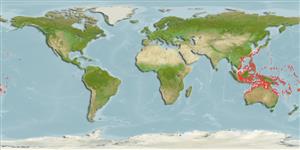Common names from other countries
>
Eupercaria/misc (Various families in series Eupercaria) >
Lethrinidae (Emperors or scavengers) > Monotaxinae
Etymology: Gymnocranius: Greek, gymnos = naked + Greek, kranion = skull (Ref. 45335).
More on author: Günther.
Environment: milieu / climate zone / depth range / distribution range
Ecología
marino asociado a arrecife; no migratorio; rango de profundidad 15 - 50 m (Ref. 2295). Tropical; 35°N - 28°S, 105°E - 170°W
Western Pacific: including southern Japan, South China Sea, Australia, Coral Sea, New Caledonia, and Tonga. Recently reported from Norfolk Island (Ref. 8881).
Tamaño / Peso / Age
Maturity: Lm ? range ? - ? cm
Max length : 45.0 cm TL macho / no sexado; (Ref. 2295); common length : 35.0 cm TL macho / no sexado; (Ref. 2295)
Espinas dorsales (total) : 10; Radios blandos dorsales (total) : 9 - 10; Espinas anales: 3; Radios blandos anales: 9 - 10.
Occurs over sand and rubble areas adjacent to rock and coral reefs in lagoons and outer slopes (Ref. 9775, 90102). Feeds on bottom-dwelling gastropods. Also caught with bottom longlines and handlines (Ref. 9775). Marketed fresh.
Life cycle and mating behavior
Maturities | Reproducción | Spawnings | Egg(s) | Fecundities | Larva
Carpenter, K.E. and G.R. Allen, 1989. FAO Species Catalogue. Vol. 9. Emperor fishes and large-eye breams of the world (family Lethrinidae). An annotated and illustrated catalogue of lethrinid species known to date. FAO Fish. Synop. 125(9):118 p. Rome: FAO. (Ref. 2295)
IUCN Red List Status (Ref. 130435)
CITES (Ref. 128078)
Not Evaluated
Threat to humans
Harmless
Human uses
Pesquerías: escaso valor comercial
Herramientas
Special reports
Download XML
Fuentes de Internet
Estimates based on models
Preferred temperature (Ref.
115969): 24.3 - 28.9, mean 27.6 (based on 408 cells).
Phylogenetic diversity index (Ref.
82804): PD
50 = 0.5010 [Uniqueness, from 0.5 = low to 2.0 = high].
Bayesian length-weight: a=0.01905 (0.01079 - 0.03365), b=2.97 (2.82 - 3.12), in cm Total Length, based on LWR estimates for this species & (Sub)family-body (Ref.
93245).
Nivel trófico (Ref.
69278): 3.8 ±0.0 se; based on diet studies.
Resiliencia (Ref.
120179): Medio, población duplicada en un tiempo mínimo de 1.4-4.4 años (K=0.22-0.24).
Fishing Vulnerability (Ref.
59153): Moderate vulnerability (40 of 100).
